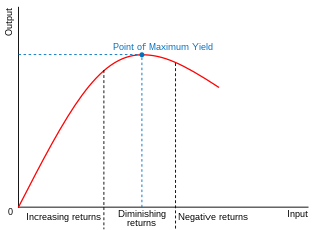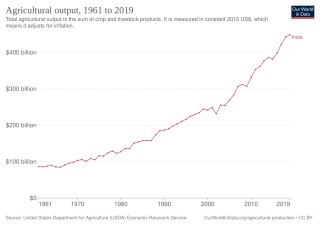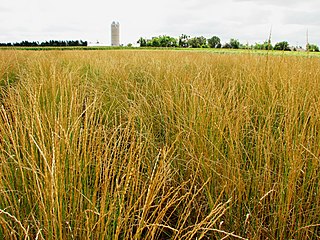In agriculture, the yield is a measurement of the amount of a crop grown, or product such as wool, meat or milk produced, per unit area of land. The seed ratio is another way of calculating yields.
Innovations, such as the use of fertilizer, the creation of better farming tools, new methods of farming and improved crop varieties, have improved yields. The higher the yield and more intensive use of the farmland, the higher the productivity and profitability of a farm; this increases the well-being of farming families. Surplus crops beyond the needs of subsistence agriculture can be sold or bartered. The more grain or fodder a farmer can produce, the more draft animals such as horses and oxen could be supported and harnessed for labour and production of manure. Increased crop yields also means fewer hands are needed on farm, freeing them for industry and commerce. This, in turn, led to the formation and growth of cities, which then translated into an increased demand for foodstuffs or other agricultural products.
The units by which the yield of a crop is usually measured today are kilograms per hectare or bushels per acre.
Long-term cereal yields in the United Kingdom were some 500 kg/ha in Medieval times, jumping to 2000 kg/ha in the Industrial Revolution, and jumping again to 8000 kg/ha in the Green Revolution. [1] Each technological advance increasing the crop yield also reduces the society's ecological footprint.[ citation needed ]
Yields are related to agricultural productivity, but are not synonymous. Agricultural productivity is measured in money produced per unit of land, but yields are measured in the weight of the crop produced per unit of land. A farmer can invest a large amount of money to increase his yields by a few percent, for example with an extremely expensive fertilizer, but if that cost is so high that it does not produce a comparative return on investment, his profits decline, and the higher yield can mean a lower agricultural productivity in this case. A yield is a 'partial measure of productivity', because it may fail to accurately measure the actual productivity of the farming operation by not including the totality of the inputs. [2]
The seed multiplication ratio is the ratio between the investment in seed versus the yield. For example, if three grains are harvested for each grain seeded, the resulting multiplication ratio is 1:3, which is considered by some agronomists as the minimum required to sustain human life. [3] One of the three seeds must be set aside for the next planting season, the remaining two either consumed by the grower, or for livestock feed. In parts of Europe the seed ratio during the 9th century was merely 1:2.5, in the Low Countries it improved to 1:14 with the introduction of the three-field system of crop rotation around the 14th century. [4]
Seed multiplication ratio is variable, subject to several factors. Agricultural improvements can raise the ratio, and revisions were recommended in 2018 by the Indian Council of Agricultural Research. [5]
Alexander Mitscherlich studied crop yields in 1909 [6] and articulated a "law of physiological relations". [7] It was compared to the law of diminishing returns in 1942, when Liebig's law of the minimum and the limiting factors of Frederick Blackman were also noted:
The relation was reviewed by Hans Schneeberger in 2009. [9]

Intensive agriculture, also known as intensive farming, conventional, or industrial agriculture, is a type of agriculture, both of crop plants and of animals, with higher levels of input and output per unit of agricultural land area. It is characterized by a low fallow ratio, higher use of inputs such as capital, labour, agrochemicals and water, and higher crop yields per unit land area.

The British Agricultural Revolution, or Second Agricultural Revolution, was an unprecedented increase in agricultural production in Britain arising from increases in labor and land productivity between the mid-17th and late 19th centuries. Agricultural output grew faster than the population over the hundred-year period ending in 1770, and thereafter productivity remained among the highest in the world. This increase in the food supply contributed to the rapid growth of population in England and Wales, from 5.5 million in 1700 to over 9 million by 1801, though domestic production gave way increasingly to food imports in the 19th century as the population more than tripled to over 35 million.

Agricultural productivity is measured as the ratio of agricultural outputs to inputs. While individual products are usually measured by weight, which is known as crop yield, varying products make measuring overall agricultural output difficult. Therefore, agricultural productivity is usually measured as the market value of the final output. This productivity can be compared to many different types of inputs such as labour or land. Such comparisons are called partial measures of productivity.

Agronomy is the science and technology of producing and using plants by agriculture for food, fuel, fiber, chemicals, recreation, or land conservation. Agronomy has come to include research of plant genetics, plant physiology, meteorology, and soil science. It is the application of a combination of sciences such as biology, chemistry, economics, ecology, earth science, and genetics. Professionals of agronomy are termed agronomists.
Liebig's law of the minimum, often simply called Liebig's law or the law of the minimum, is a principle developed in agricultural science by Carl Sprengel (1840) and later popularized by Justus von Liebig. It states that growth is dictated not by total resources available, but by the scarcest resource. The law has also been applied to biological populations and ecosystem models for factors such as sunlight or mineral nutrients.

The Three Sisters are the three main agricultural crops of various indigenous peoples of Central and North America: squash, maize ("corn"), and climbing beans. In a technique known as companion planting, the maize and beans are often planted together in mounds formed by hilling soil around the base of the plants each year; squash is typically planted between the mounds. The cornstalk serves as a trellis for climbing beans, the beans fix nitrogen in their root nodules and stabilize the maize in high winds, and the wide leaves of the squash plant shade the ground, keeping the soil moist and helping prevent the establishment of weeds.

Alexander Mitscherlich was a German chemist and son of Eilhard Mitscherlich.

In economics, diminishing returns are the decrease in marginal (incremental) output of a production process as the amount of a single factor of production is incrementally increased, holding all other factors of production equal. The law of diminishing returns states that in productive processes, increasing a factor of production by one unit, while holding all other production factors constant, will at some point return a lower unit of output per incremental unit of input. The law of diminishing returns does not cause a decrease in overall production capabilities, rather it defines a point on a production curve whereby producing an additional unit of output will result in a loss and is known as negative returns. Under diminishing returns, output remains positive, but productivity and efficiency decrease.

Roman agriculture describes the farming practices of ancient Rome, during a period of over 1000 years. From humble beginnings, the Roman Republic and the Roman Empire expanded to rule much of Europe, northern Africa, and the Middle East and thus comprised many agricultural environments of which the Mediterranean climate of dry, hot summers and cool, rainy winter was the most common. Within the Mediterranean area, a triad of crops were most important: grains, olives, and grapes.
Biointensive agriculture is an organic agricultural system that focuses on achieving maximum yields from a minimum area of land, while simultaneously increasing biodiversity and sustaining the soil fertility. The goal of the method is long term sustainability on a closed system basis. It is particularly effective for backyard gardeners and smallholder farmers in developing countries, and also has been used successfully on small-scale commercial farms.

A smallholding or smallholder is a small farm operating under a small-scale agriculture model. Definitions vary widely for what constitutes a smallholder or small-scale farm, including factors such as size, food production technique or technology, involvement of family in labor and economic impact. Smallholdings are usually farms supporting a single family with a mixture of cash crops and subsistence farming. As a country becomes more affluent, smallholdings may not be self-sufficient, but may be valued for the rural lifestyle. As the sustainable food and local food movements grow in affluent countries, some of these smallholdings are gaining increased economic viability. There are an estimated 500 million smallholder farms in developing countries of the world alone, supporting almost two billion people.

The history of agriculture in India dates back to the Neolithic period. India ranks second worldwide in farm outputs. As per the Indian economic survey 2020 -21, agriculture employed more than 50% of the Indian workforce and contributed 20.2% to the country's GDP.

Intensive crop farming is a modern industrialized form of crop farming. Intensive crop farming's methods include innovation in agricultural machinery, farming methods, genetic engineering technology, techniques for achieving economies of scale in production, the creation of new markets for consumption, patent protection of genetic information, and global trade. These methods are widespread in developed nations.

For millennia, agriculture has played an important role in the Chinese economy and society. By the time the People's Republic of China was established in 1949, virtually all arable land was under cultivation; irrigation and drainage systems constructed centuries earlier and intensive farming practices already produced relatively high yields. But little prime virgin land was available to support population growth and economic development. However, after a decline in production as a result of the Great Leap Forward (1958–60), agricultural reforms implemented in the 1980s increased yields and promised even greater future production from existing cultivated land.

Thinopyrum intermedium, known commonly as intermediate wheatgrass, is a sod-forming perennial grass in the Triticeae tribe of Pooideae native to Europe and Western Asia. It is part of a group of plants commonly called wheatgrasses because of the similarity of their seed heads or ears to common wheat. However, wheatgrasses generally are perennial, while wheat is an annual. It has gained the Royal Horticultural Society's Award of Garden Merit as an ornamental.
Deficit irrigation (DI) is a watering strategy that can be applied by different types of irrigation application methods. The correct application of DI requires thorough understanding of the yield response to water and of the economic impact of reductions in harvest. In regions where water resources are restrictive it can be more profitable for a farmer to maximize crop water productivity instead of maximizing the harvest per unit land. The saved water can be used for other purposes or to irrigate extra units of land. DI is sometimes referred to as incomplete supplemental irrigation or regulated DI.

Farming systems in India are strategically utilized, according to the locations where they are most suitable. The farming systems that significantly contribute to the agriculture of India are subsistence farming, organic farming, industrial farming. Regions throughout India differ in types of farming they use; some are based on horticulture, ley farming, agroforestry, and many more. Due to India's geographical location, certain parts experience different climates, thus affecting each region's agricultural productivity differently. India is very dependent on its monsoon cycle for large crop yields. India's agriculture has an extensive background which goes back to at least 9 thousand years. In India, in the alluvial plains of the Indus River in Pakistan, the old cities of Mohenjo-Daro and Harappa experienced an apparent establishment of an organized farming urban culture. That society, known as the Harappan or Indus civilization, flourished until shortly after 4000 BP; it was much more comprehensive than those of Egypt or Babylonia and appeared earlier than analogous societies in northern China. Currently, the country holds the second position in agricultural production in the world. In 2007, agriculture and other industries made up more than 16% of India's GDP. Despite the steady decline in agriculture's contribution to the country's GDP, agriculture is the biggest industry in the country and plays a key role in the socio-economic growth of the country. India is the second-largest producer of wheat, rice, cotton, sugarcane, silk, groundnuts, and dozens more. It is also the second biggest harvester of vegetables and fruit, representing 8.6% and 10.9% of overall production, respectively. The major fruits produced by India are mangoes, papayas, sapota, and bananas. India also has the biggest number of livestock in the world, holding 281 million. In 2008, the country housed the second largest number of cattle in the world with 175 million.
Convertible husbandry, also known as alternate husbandry or up-and-down husbandry, is a method of farming whereby strips of arable farmland were temporarily converted into grass pasture, known as leys. These remained under grass for up to 10 years before being ploughed under again, while some eventually became permanent pasturage. It was a process used during the 16th century through the 19th century by "which a higher proportion of land was used to support increasing numbers of livestock in many parts of England." Its adoption was an important component of the British Agricultural Revolution.

Agriculture in the Middle Ages describes the farming practices, crops, technology, and agricultural society and economy of Europe from the fall of the Western Roman Empire in 476 to approximately 1500. The Middle Ages are sometimes called the Medieval Age or Period. The Middle Ages are also divided into the Early, High, and Late Middle Ages. The early modern period followed the Middle Ages.
This glossary of agriculture is a list of definitions of terms and concepts used in agriculture, its sub-disciplines, and related fields, including horticulture, animal husbandry, agribusiness, and agricultural policy. For other glossaries relevant to agricultural science, see Glossary of biology, Glossary of ecology, Glossary of environmental science, and Glossary of botanical terms.
Ritchie, Hannah; Rosado, Pablo; Roser, Max (2022). "Crop yields". Our World in Data . Retrieved 2024-04-20.